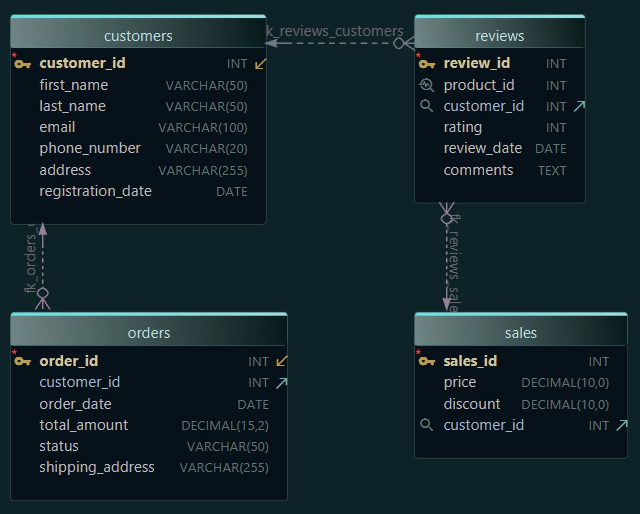Create ER Diagrams for MySQL with a Free GUI Tool
When learning or working with a database, the first step is to see how the tables connect. For MySQL users, the easiest way to do that is with an Entity-Relationship Diagram (ERD). Instead of reading long SQL scripts, an ER diagram gives you a clear picture of tables, keys, and relationships.
In this guide, I’ll use DbSchema - a free design tool for creating ER diagrams. It also includes extra features such as HTML5 documentation (for up to 12 tables in the free edition) and Git integration if you try the PRO version.
We’ll look at two main cases:
- Reverse engineer an existing MySQL database
- Build a new schema visually
What Is an ER Diagram?
An ER diagram is a drawing of your database. It shows tables (entities), their columns, and how they are connected with primary and foreign keys.
It usually includes:
- Table names and their columns
- Keys (primary and foreign)
- Relationships between tables
- Notes, data types, and indexes

If You Already Have a Database
With DbSchema, you don’t need to draw everything by hand. You can reverse engineer your MySQL database: the tool connects to your schema, reads the tables and foreign keys, and builds a diagram automatically.
Here’s an example of a MySQL schema as an ER diagram:

Want step-by-step instructions? Check the documentation here
Designing a Schema Visually
Sometimes you don’t have a database yet, you just have an idea.
Instead of starting with CREATE TABLE statements, you can draw it out:
- Add new tables with a click
- Define columns, data types, and keys using simple forms
- Drag lines between tables to create relationships
- Rearrange the diagram for clarity
When ready, you can generate the SQL code automatically.
Learn more about designing schemas visually
1. Organize with Multiple Layouts
If your database only has a few tables, one diagram might be enough. But once you start adding more, things can get messy.
In DbSchema, you can create multiple layouts of the same schema. For example:
- A diagram showing user and authentication tables
- A separate one for products and orders
- Another one for reporting or logs
All layouts still point to the same schema, but splitting them up keeps them clear and readable. This is especially useful in large MySQL databases where hundreds of tables exist.
2. Keep It Synchronized
Databases are never static - columns get added, constraints change, and indexes are tuned.
With DbSchema’s Schema Compare feature, you can:
- Compare the diagram with the live MySQL database
- See exactly what changed (new tables, dropped columns, altered constraints)
- Choose whether to update the diagram or apply changes back to the database
This prevents surprises and ensures the diagram and the real database stay in sync. It’s like a two-way mirror - you can decide which side becomes the source of truth.

in the Model
in the Database
3. Use Git for Version Control
Your diagram is saved in a project file (.dbs). This file can be committed to Git just like code, which means:
- You can track every change (e.g., when a column is renamed or a new table is added)
- Work in a team without overwriting each other’s changes
- Roll back to earlier versions if a design decision didn’t work out
- Keep schema design history alongside your application code
This makes database design a collaborative process, not just a one-person job.

using Git integration
4. Share with HTML5 Documentation
Not everyone on your team knows SQL, but they might still need to understand the database.
With DbSchema, you can export your ER diagram as interactive HTML5 documentation:
- Opens in any browser (no installation required)
- Tables are clickable - you can see all the details from the columns and constraints
- Notes and comments are included
- Great for sending to managers, analysts, or clients
It’s like publishing your schema online in a clickable, explorable form.

Works with any browser
in the diagram
complete details
relationships, metadata
5. Notes and Comments
Sometimes a diagram isn’t enough. People want to know why something is designed in a certain way.
In DbSchema, you can add:
- Notes on tables (e.g., "This table stores archived orders older than 2 years")
- Notes on relationships (e.g., "One customer can have multiple addresses")
- Comments on columns (e.g., "This column is auto-incremented for IDs")
These annotations are not just helpful for your teammates. They also show up in the exported HTML docs, making your schema easier to understand for anyone who reads it.

6. Export Options
Once you’re done, you can export your design in different ways:
- Images (PNG, PDF) for reports or presentations
- SQL scripts to deploy your schema
- Interactive HTML5 for easy sharing with teammates
Benefits of Using DbSchema for MySQL ER Diagrams
| Feature | Description |
|---|---|
| Free Version Available | Create diagrams without a license |
| Visual Interface | Build schemas without typing SQL |
| Offline Mode | Work even without a live MySQL connection |
| Schema Compare | Spot differences between model and database |
| HTML5 Documentation | Generate clickable docs |
| Git Integration | Keep track of schema changes in teams |
| Multi-Database Support | Works with PostgreSQL, Oracle, SQL Server, and more |
Conclusion
For MySQL users, ER diagrams are the easiest way to understand and manage a schema. They make relationships clear, reduce mistakes, and improve teamwork.
Whether you’re documenting an old database or planning a new one, drawing it visually makes the job simpler.
You can try all of this with the free version of DbSchema – a straightforward tool to design, organize, and share MySQL databases.







